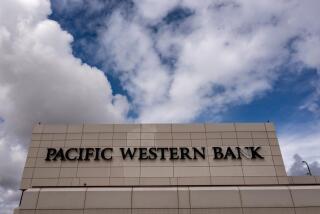Texas Banks Get Delayed Reaction to Oil-Patch Ills
HOUSTON â In the market for a 378-acre ranch in the Texas Hill Country, complete with lagoon-style swimming pool, guest quarters and frontage on a river?
How about a 17-story Ramada Inn in College Station, Tex., with a four-bedroom, four-bath penthouse?
Or, perhaps, one of 45 homes in a subdivision just off Galveston Bay?
These properties--and many more--will be auctioned Tuesday by the folks at Federal Deposit Insurance Corp., the government agency in business to protect depositors against bank failures.
The auction--billed as the biggest FDIC liquidation sale in Texas history--should bring in a minimum of $30 million.
And the reason for the sale is now a familiar one, both in Texas and the rest of the Energy Belt: another bank has gone under.
In Texas alone, a record 29 banks have failed already this year--more than one a week. With less than half the year gone, that total surpasses last yearâs record 26 failures.
Oklahoma, the next hardest-hit state in the country, has already recorded 13 bank closings. Add Coloradoâs six failures and four more in Louisiana and the totals are staggering.
Of 85 bank failures around the nation this year, 52 were in those four states, where oil and gas are the mainstays of the economy.
The Houston office of the FDIC alone is trying to liquidate more than $500 million in loans. âWeâre the fifth-largest bank in Houston,â said Tim Putman, the director of the local office.
The bank closures thus far are not the end of the somber news. If the present trend continues, an estimated 200 banks will close their doors by the end of the year, the largest number since the Great Depression.
Last year, 138 banks failed, and that, too, was a record.
Of the failures this year, the greatest number by far will be in Texas, where former state banking Chairman Jim Sexton predicts that, on a straight line projection, 66 banks could close their doors by the end of December.
What is happening to banks this year is a belated reflection of what has been happening to the Energy Belt for the last couple of years, not only in the precipitous drop of the oil and gas sector, but also overbuilding that went on during the boom times. It has just taken this long for the money crunch to hit the banks, traditionally one of the last to suffer when an economy falters.
âItâs kind of like the battle is over,â said analyst Frank Anderson of the Dallas-based brokerage Ferguson & Co. âNow they are going back and shooting all the wounded.â
Banking analyst Sandra Flannigan of Paine Webber Inc. attributes the record number of closings to several factors.
âWe had an unprecedented drop in oil prices that caught everyone by surprise. Then you had flagrant overbuilding,â she said. âCombined with those two things, the state is in a recession and itâs led to unprecedented problems for the Texas banks.
âWe think there are still difficult times ahead for the Texas banks,â she said.
Too Many Banks
That is not to say, though, that the banks of the Energy Belt are wheezing their last gasp. Texas alone has an estimated 2,000 banks and Oklahoma has more than 500. The bad loans at the 42 failed banks in both states, most of them small, are a drop in the bucket compared to the overall assets of the 2,500 banks that remain solvent. Anderson and others argue that perhaps there were too many banks in the first place--âoverbanked,â as he put it.
âA lot of people were getting into banking who didnât have the expertise,â he said. âFor awhile there, it was getting out of hand. Texas has 2,000 banks. Is there a need for that many? I donât think there is.â
But banks with problems in the Energy Belt run the gamut, from the very small to the regionâs giants.
On the small side, there is, for example, the Cordell (Okla.) National Bank, in the heart of the stateâs western oil and natural gas fields. The bank, which had been owned by the same family since 1903, was closed by bank examiners last year.
Bob Harris, a spokesman for the Oklahoma Bankersâ Assn., said the only fault of then-President Frank Kliewer was that he lent money to people who had been doing business with him for years.
âHe tried to keep the community afloat,â Harris said.
The day after the bank folded, Kliewer ran an ad in the local newspaper, the Cordell Beacon, pledging to pay back anyone who lost money with the closure, even going so far as to say he would do so in death if not while he was alive by willing his life insurance policy to his customers.
Difficult to Refuse
Kliewer admits he made some mistakes with his lending policies, but said that it was difficult to turn down loan requests from people he had been doing business with for years.
âWe were friends with all our customers, maybe too friendly,â he said. âSometimes you canât see the forest from the trees.â
The story of the Cordell bank, though, is only one part of the picture. Putman said many other banks were started during the boom years and were used as money machines by board members who were also developers. They used their status within the bank to obtain easy loans that might have otherwise been denied.
âMany banks that failed did so because they had builders on their boards,â said Putman. âBecause of connections, they (the lenders) went the last mile.â
Only last Thursday, the First State Bank of Frisco, Tex., was closed, and the FDIC said a substantial number of bad loans to principal shareholders and their associates was a primary cause for its failure.
âA lot of the banks were mismanaged,â Anderson said.
In the case of larger Texas and Oklahoma financial institutions, the tough times in the Oil Patch have brought on a revolution in the way of doing business.
Before the oil crunch, both states were like fortresses for the banking industry. No bank from outside the states could merge with a Texas or Oklahoma bank. No branch banking was allowed inside either state. Because of those two laws, local banks found themselves unable to bring in new capital from more prosperous areas of the country and unable to streamline their operations with a system of branches.
Laws Were Changed
But that all changed last year, when the legislatures of both states approved mergers and branch banking, giving financial institutions--especially larger ones--more options.
âIt brings us closer to the 20th Century,â said Mike Cinelli, a spokesman for Texas Commerce Bancshares, which is based in Houston.
Sexton, the former Texas banking commissioner, said the oil crunch made legislators realize that they had to do something for the banks or face a major crisis.
âThe only way we got it was a crisis and a little bit of realism about our crisis,â he said.
Since then, there have been several mergers in Texas, both in and out of state, that have helped shore up some of the largest banks. And Harris of the Oklahoma Banking Assn. said he anticipates several more merger announcements after July 1, the date set by the Legislature for mergers to begin.
In Texas, Allied Bancshares has merged with California-based First Interstate Bancorp. Chemical New York Corp. has acquired Texas Commerce Bancshares. And late last month, Interfirst Corp. of Dallas acquired its longtime, cross-town rival, RepublicBank Corp.
Some trouble spots still remain, most notably First City Bancorp. of Texas, which posted a $402-million loss in 1986. So far, the troubled bank holding company has found no buyer or partner.
Despite the problems, Anderson remains guardedly optimistic about the future of banks in Texas. There is no question that more banks will fail, but reality has set in, he believes. No longer will there be the quick-and-easy $1-million loans of the past.
âThe worst in terms of identifying problems is behind us,â Anderson said. âThe main thing is weâve had less than 1.5% of the banks fail in Texas. When you think of the strains on the economy, itâs remarkable we havenât had more fallout than weâve seen.â
More to Read
Sign up for Essential California
The most important California stories and recommendations in your inbox every morning.
You may occasionally receive promotional content from the Los Angeles Times.










